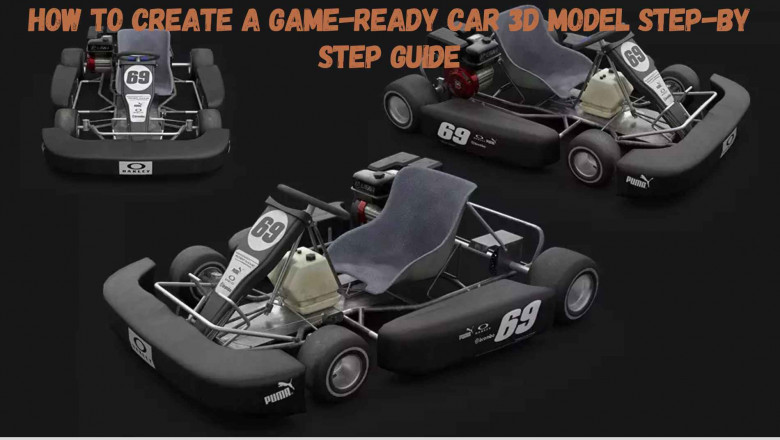views
Creating a game-ready car 3D model is a must-have skill for any aspiring or professional 3D artist working in the game industry. Vehicles are a staple in racing games, open-world adventures, and simulation experiences, and when crafted properly, they become high-impact 3D game assets that elevate the entire experience.
In this guide, we’ll walk you through each essential phase of the process, from initial planning to final export. Whether you're a beginner or brushing up on your workflow, this breakdown will help you master the art of 3D vehicle modeling using best practices in hard surface modeling.
Step 1: Collect References and Analyze Design
Before opening your 3D software, gather visual references. This includes orthographic blueprints, real car photos, and concept sketches. Analyzing how cars are built in real life helps in understanding form, proportions, and technical details.
Why this matters:
Creating believable assets for 3D modeling games starts with strong reference material. Your model should reflect the theme and style of the overall 3D game environment it will exist in.
Step 2: Blocking Out the Base Mesh
Start with a simple block-out of the car’s overall silhouette using primitive shapes like cubes and planes. Don’t worry about details yet—focus on getting the scale and major forms right.
Goal of this stage:
-
Build a solid foundation for your car 3D model
-
Ensure proportional accuracy
-
Maintain a clean topology for later stages
This early layout serves as the backbone for your future 3D hard surface modeling steps.
Step 3: Sculpting the Body with Hard Surface Techniques
With the block-out complete, begin shaping the panels, hood, roof, doors, and other core sections. Use bevels, loops, and chamfers to define crisp edges and clean transitions.
This step falls under Hard Surface Modeling, which is the backbone of creating realistic mechanical assets like cars, weapons, or architecture in 3D modeling games.
Tips:
-
Stick to a quad topology for smooth subdivision
-
Minimize polygons without sacrificing form
-
Model with the game engine’s performance in mind
Step 4: Modeling Accessories and Props
Once the car body is done, add smaller components: wheels, mirrors, headlights, grills, wipers, and interior seats. These are treated as separate props 3D model elements but must blend visually with the main mesh.
Each part should be optimized to function as reusable 3D game assets, especially in modular systems used in large-scale 3D game environments.
Step 5: UV Mapping and Baking Details
After modeling, create a well-organized UV map. Use overlapping UVs where possible to conserve texture space, especially for symmetrical parts like tires.
Next:
-
Bake high-resolution details into normal maps
Baking is a critical step in 3D environment modeling, allowing detailed visuals while keeping your 3D vehicle modeling light and engine-ready.
Step 6: Texturing the Car for Games
Use a PBR (Physically-Based Rendering) texturing workflow to apply realistic materials like metal, paint, rubber, and glass. Tools like Substance Painter or Quixel Mixer are ideal for painting directly onto the model.
Texture sets usually include:
-
Albedo/Base Color
-
Roughness
-
Metallic
-
Normal Map
-
Ambient Occlusion
For 3D modeling games, optimize texture resolution—2K is ideal for most in-game cars. Keep your materials performance-friendly while still being visually rich.
Step 7: Rigging and Exporting
If your car has movable parts—like spinning wheels or opening doors—add simple rigging or object parenting to allow for animation in-game.
Final checks before export:
-
Set the correct scale and orientation
-
Freeze transformations
-
Export in engine-friendly formats like FBX or GLTF
Step 8: Optimize for Real-Time Performance
Your car must look great and run smoothly. Reduce unnecessary geometry, use LOD (Level of Detail) models, and make sure your UV layout avoids wasted texture space.
Optimization ensures your car 3D model can be used efficiently alongside other 3D game assets and props in large-scale 3D game environments without impacting frame rate.
Final Thoughts
Creating a polished, optimized, and visually impressive 3D vehicle model isn’t just about sculpting a cool car—it’s about understanding how the asset will function within a broader 3D game environment.
By combining solid hard surface modeling techniques with UV efficiency, baking, and real-time optimization, you’ll produce 3D game assets that perform flawlessly and look fantastic. Whether it's for a racing game or an open-world sandbox, a well-made car adds immersive value and dynamic gameplay opportunities.






















Comments
0 comment